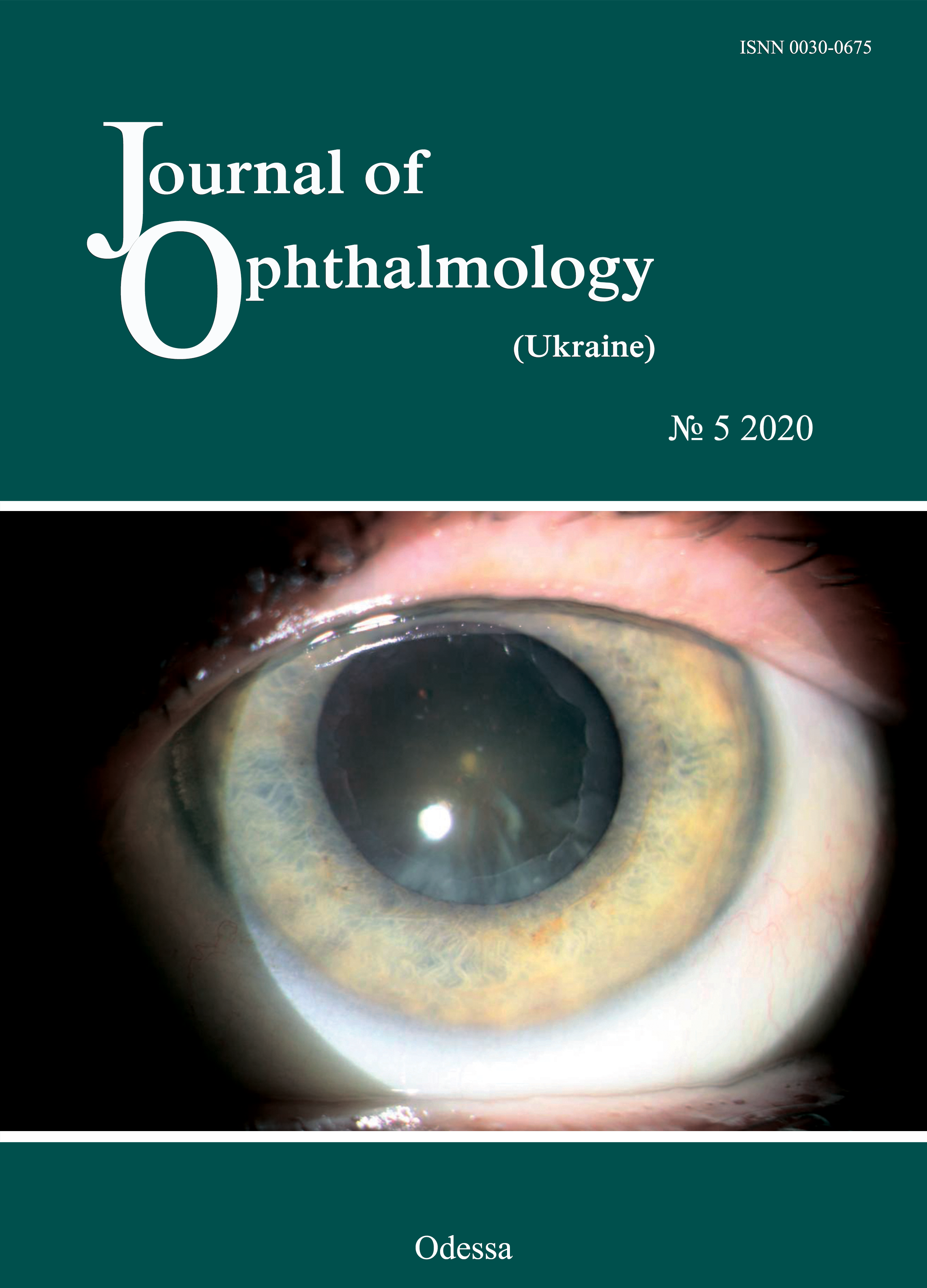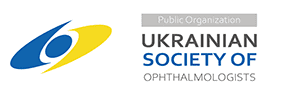Levels of pro-inflammatory (TNF-α and IL -6) and anti-inflammatory (IL -10 and IL- 4) interleukins in ocular herpes patients with frequent and infrequent recurrences
DOI:
https://doi.org/10.31288/oftalmolzh202051320Keywords:
herpetic stromal keratitis, cytokines, TNF-α, IL-10, IL-4Abstract
Background: Herpes simplex virus ocular infection is the major cause of corneal blindness in developed countries. The methods used for the treatment of recurrent herpes infections give only temporary remission, and the results of studies on prevention and prediction of the course of the disease are contradictory, which makes management of these infections not only medically, but also socially important. The mechanism of recurrence of herpetic stromal keratitis (HSK) infection has not been clearly understood, since the disease involves complex pathophysiological mechanisms and immune factors (including cytokines) are complexly interrelated in the pathogenesis.
Purpose: To assess serum levels of proinflammatory cytokines (TNF-α and IL-6) and anti-inflammatory cytokines (IL-10 and IL-4) in ocular HSK patients with frequent and infrequent recurrences during remission and recurrence.
Material and Methods: Thirty-three in-patients (15 patients and 18 patients experiencing less than and more than one recurrence annually, respectively) treated for recurrent HSK at the Department of Corneal Disorders of the Filatov Institute were included in the study. Serum IL-4, IL-6, IL-10 and TNF-α levels were determined using enzyme-linked immunosorbent assay (ELISA) kits from Vektor-Best (Novosibirsk, Russia) according to the manufacturer’s instruction. Photometric measurements were performed on an ELISA plate reader (Stat Fax 2100, Awareness Technologies Inc, Palm City, FL). Reference normal values were taken from the manufacturer’s instructions.
Results: We found that the mean serum TNF-α level in patients with infrequent recurrences and in those with frequent recurrences during remission was 2.6 times and 4 times, respectively, higher, and during recurrence, 5.6 times higher, compared to normal values, which is likely to indicate a subclinical inflammatory process. Both in patients with infrequent recurrences and in those with frequent recurrences of keratitis, the mean serum TNF-α level was 50% higher during recurrence than during remission. The mean serum IL-6 level during remission was comparable to, and during recurrence was 3 times higher than the norm, with no significant difference between patients with infrequent and frequent recurrences. Serum IL-4 levels in patients with infrequent and frequent recurrences were 8.5 times and 22.5 times, respectively, higher than reference values. During recurrence, the mean serum IL-4 level in patients with frequent recurrences was 39% higher than in those with infrequent recurrences. No significant difference was observed in serum IL-10 level between remission and recurrence for patients with infrequent recurrences, with a mean value being 24% higher than reference values. The mean serum IL-10 level (for recurrence and remission) in patients with frequent recurrences was 74% higher than for patients with infrequent recurrences (p = 0.01), and two times higher than reference values.
Conclusion: HSK in patients with frequent recurrences was characterized by the pattern of regulation of cytokine expression, with decreased expression of TNF-α and increased expression of pro-inflammatory (IL-6) and anti-inflammatory (IL-10 and IL-4) interleukins, which might reflect a mechanism of autoimmune response in such a course of herpetic keratitis.
References
1.Darougar S, Wishart MS, Viswalingam ND. Epidemiological and clinical features of primary herpes simplex virus ocular infection. Br J Ophthalmol. 1985 Jan; 69(1):2-6. https://doi.org/10.1136/bjo.69.1.2
2.Cherevko NA. [Immunological mechanisms of reactivation of herpetic infection its relationship with allergopathology]. Dr Sc (Med) Dissertation. Tomsk: Siberian State Medical University; 2012. Russian.
3.Gaddipati S., Estrada K., Rao P., Jerome A. D., Suvas S. IL-2/anti-IL-2 antibody complex treatment inhibits the development but not the progression of herpetic Stromal Keratitis. J Immunol. 2015;194(1):273-82.https://doi.org/10.4049/jimmunol.1401285
4.Tang Q, Chen W, Hendricks RL. Proinflammatory functions of IL-2 in herpes simplex virus corneal infection. J Immunol. 1997 Feb 1; 158(3):1275-83.https://doi.org/10.4049/jimmunol.158.3.1275
5.Karasneh GA, Shukla D Herpes simplex virus infects most cell types in vitro: clues to its success. Virol J. 2011 Oct 26; 8():481. https://doi.org/10.1186/1743-422X-8-481
6.Miller CS, Danaher RJ, Jacob RJ. Мolecular aspects of herpes simplex virus I latency, reactivation, and recurrence. Crit Rev Oral Biol Med. 1998; 9(4):541-62. https://doi.org/10.1177/10454411980090040901
7.Staats HF, Lausch RN Cytokine expression in vivo during murine herpetic stromal keratitis. Effect of protective antibody therapy. J Immunol. 1993 Jul 1; 151(1):277-83.https://doi.org/10.4049/jimmunol.151.1.277
8.Thomas J, Gangappa S, Kanangat S, Rouse BT. On the essential involvement of neutrophils in the immunopathologic disease: herpetic stromal keratitis. J Immunol. 1997;158:1383-91.https://doi.org/10.4049/jimmunol.158.3.1383
9.Tsatsos M, MacGregor C, Athanasiadis I, Moschos MM, Hossain P, Anderson D Herpes simplex virus keratitis: an update of the pathogenesis and current treatment with oral and topical antiviral agents. Clin Exp Ophthalmol. 2016 Dec; 44(9):824-37.https://doi.org/10.1111/ceo.12785
10.Liesegang TJ. Ocular herpes simplex infection: pathogenesis and current therapy. Mayo Clin Proc. 1988;63:1092-105).https://doi.org/10.1016/S0025-6196(12)65504-9
11.Frank GM, Buela KA, Maker DM, Harvey SA, Hendricks RL. Early responding dendritic cells direct the local NK response to control herpes simplex virus 1 infection within the cornea. J Immunol. 2012;188:1350-1359.https://doi.org/10.4049/jimmunol.1101968
12.Zhang J, An J. Cytokines, inflammation, and pain. Int Anesthesiol Clin. Spring 2007;45(2):27-37. https://doi.org/10.1097/AIA.0b013e318034194e
13.Azher TN, Yin XT, Stuart PM. Understanding the Role of Chemokines and Cytokines in Experimental Models of Herpes Simplex Keratitis. J Immunol Res. 2017;2017:7261980.https://doi.org/10.1155/2017/7261980
14.Daheshia M, Kanangat S, Rouse BT. Production of key molecules by ocular neutrophils early after herpetic infection of the cornea. Exp Eye Res. 1998 Dec;67(6):619-24.https://doi.org/10.1006/exer.1998.0565
15.Suryawanshi A, Veiga-Parga T, Rajasagi NK, Reddy PB, Sehrawat S, Sharma S, Rouse BT. Role of IL-17 and Th17 cells in herpes simplex virus-induced corneal immunopathology. J Immunol. 2011 Aug 15;187(4):1919-30.https://doi.org/10.4049/jimmunol.1100736
16.Molesworth-Kenyon SJ, Yin R, Oakes JE, Lausch RN. IL-17 receptor signaling influences virus-induced corneal inflammation. J Leukoc Biol. 2008 Feb;83(2):401-8.https://doi.org/10.1189/jlb.0807571
17.Biswas PS, Banerjee K, Kinchington PR, Rouse BT. Involvement of IL-6 in the paracrine production of VEGF in ocular HSV-1 infection. Exper Eye Res. 2006 Jan;82(1):46-54.https://doi.org/10.1016/j.exer.2005.05.001
18.Yan XT, Zhuang M, Oakes JE, Lausch RN. Autocrine action of IL-10 suppresses proinflammatory mediators and inflammation in the HSV-1-infected cornea. J Leukoc Biol. 2001 Jan;69(1):149-57.https://doi.org/10.1189/jlb.69.1.149
19.Tumpey TM, Cheng H, Cook DN, Smithies O, Oakes JE, Lausch RN. Absence of macrophage inflammatory protein-1α prevents the development of blinding herpes stromal keratitis. J Virol. 1998;72(5):3705-3710.https://doi.org/10.1128/JVI.72.5.3705-3710.1998
20.Tang Q, Hendricks RL. Interferon gamma regulates platelet endothelial cell adhesion molecule 1 expression and neutrophil infiltration into herpes simplex virus-infected mouse corneas. J Exp Med. 1996;184(4):1435-47.https://doi.org/10.1084/jem.184.4.1435
21.Jan XT, Zhuang M, Oakes JE, Lausch RN. Autocrine action of IL-10 suppresses proinflammatory mediators and inflammation in the HSV-1-infected cornea. J Leukoc Biol. 2001 Jan;69(1):149-57.https://doi.org/10.1189/jlb.69.1.149
22.Tumpey TM, Cheng H, Yan XT, et al. Chemokine synthesis in the HSV-1 infected cornea and its suppression by interleukin-10. J Leukoc Biol. 1998;63:486-92.https://doi.org/10.1002/jlb.63.4.486
23.Rao P, Suvas S. Development of Inflammatory Hypoxia and Prevalence of Glycolytic Metabolism in Progressing Herpes Stromal Keratitis Lesions. J Immunol. 2019;202(2):514-526.https://doi.org/10.4049/jimmunol.1800422
24.Bock F, Maruyama K, Regenfuss B, Hos D, Steven P, Heindl LM, Cursiefen C. Novel anti(lymph)angiogenic treatment strategies for corneal and ocular surface diseases. Prog Retin Eye Res. 2013 May; 34():89-124.https://doi.org/10.1016/j.preteyeres.2013.01.001
25.Wuest T. R., Carr D. J. VEGF-A expression by HSV-1-infected cells drives corneal lymphangiogenesis. The Journal of Experimental Medicine. 2010;207(1):101-115.https://doi.org/10.1084/jem.20091385
26.Lobo AM, Agelidis AM, Shukla D. Pathogenesis of herpes simplex keratitis: The host cell response and ocular surface sequelae to infection and inflammation. Ocul Surf. 2019 Jan;17(1):40-49.https://doi.org/10.1016/j.jtos.2018.10.002
27.Derbasova NN. [Features of immune impairments in ocular herpetic infection and clinical and immunological efficacy of various therapeutic regimens]. Abstract of Cand Sc (Med) Thesis. Vladivostok: Vladivostok State Medical University; 2007. Russian.
28.West DM, Del Rosso CR, Yin XT, Stuart PM. CXCL1 but not IL-6 is required for recurrent herpetic stromal keratitis. J Immunol. 2014;192(4):1762-67.https://doi.org/10.4049/jimmunol.1302957
29.Sekine-Okano M, Lucas R, Rungger D, et al. Expression and release of tumor necrosis factor-alpha by explants of mouse cornea. Invest Ophthalmol Vis Sci. 1996;37:1302-10.
30.Keadle TL, Usui N, Laycock KA, Miller JK, Pepose JS, Stuart PM. IL-1 and TNF-alpha are important factors in the pathogenesis of murine recurrent herpetic stromal keratitis. Invest Ophthalmol Vis Sci. 2000;41 (1):96-102.
31.Minagawa H, Hashimoto K, Yanagi Y. Absence of tumour necrosis factor facilitates primary and recurrent herpes simplex virus-1 infections. J Gen Virol. 2004 Feb;85(Pt 2):343-7.https://doi.org/10.1099/vir.0.19627-0
32.Fenton RR, Molesworth-Kenyon S, Oakes JE, Lausch RN. Linkage of IL-6 with neutrophil chemoattractant expression in virus-induced ocular inflammation. Invest Ophthalmol Vis Sci. 2002 Mar;43(3):737-43.
33.Ghiasi H, Cai S, Slanina SM, Perng GC, Nesburn AB, Wechsler SL. The role of interleukin (IL)-2 and IL-4 in herpes simplex virus type 1 ocular replication and eye disease. J Infect Dis. 1999 May;179(5):1086-93.https://doi.org/10.1086/314736
34.Sarangi PP, Sehrawat S, Suvas S, Rouse BT. IL-10 and natural regulatory T cells: two independent anti-inflammatory mechanisms in herpes simplex virus-induced ocular immunopathology. J Immunol. 2008 May 1; 180(9):6297-306.https://doi.org/10.4049/jimmunol.180.9.6297
35.Atan D, Fraser-Bell S, Plskova J, Kuffova L, Hogan A, Tufail A, et al. Cytokine polymorphism in noninfectious uveitis. Invest Ophthalmol Vis Sci. 2010 Aug; 51(8):4133-42.https://doi.org/10.1167/iovs.09-4583
36.Ghasemi H, Ghazanfari T, Yaraee R, et al. Roles of IL-10 in ocular inflammations: a review. Ocul Immunol Inflamm. 2012 Dec;20(6):406-18.https://doi.org/10.3109/09273948.2012.723109
37.Abu El-Asrar AM, Berghmans N, Al-Obeidan SA, et al. Expression of interleukin (IL)-10 family cytokines in aqueous humour of patients with specific endogenous uveitic entities: elevated levels of IL-19 in human leucocyte antigen-B27-associated uveitis. Acta Ophthalmol. 2019;97(5):e780-e784.https://doi.org/10.1111/aos.14039
Downloads
Published
How to Cite
Issue
Section
License
Copyright (c) 2025 Н. И. Храменко, Т. Б. Гайдамака, Г. И. Дрожжина, Л. Н. Величко

This work is licensed under a Creative Commons Attribution 4.0 International License.
This work is licensed under a Creative Commons Attribution 4.0 International (CC BY 4.0) that allows users to read, download, copy, distribute, print, search, or link to the full texts of the articles, or use them for any other lawful purpose, without asking prior permission from the publisher or the author as long as they cite the source.
COPYRIGHT NOTICE
Authors who publish in this journal agree to the following terms:
- Authors hold copyright immediately after publication of their works and retain publishing rights without any restrictions.
- The copyright commencement date complies the publication date of the issue, where the article is included in.
DEPOSIT POLICY
- Authors are permitted and encouraged to post their work online (e.g., in institutional repositories or on their website) during the editorial process, as it can lead to productive exchanges, as well as earlier and greater citation of published work.
- Authors are able to enter into separate, additional contractual arrangements for the non-exclusive distribution of the journal's published version of the work with an acknowledgement of its initial publication in this journal.
- Post-print (post-refereeing manuscript version) and publisher's PDF-version self-archiving is allowed.
- Archiving the pre-print (pre-refereeing manuscript version) not allowed.












